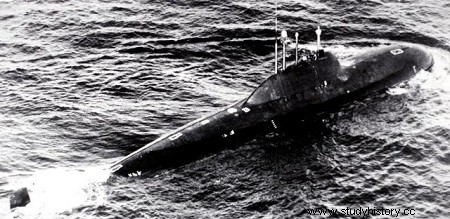
Alfa class
Project 705 Lyra
Project 705 "Lyra" is a class of Soviet nuclear attack submarines, known in the West by its NATO code Alfa class. They were the fastest submarines in the world, and those for military use that could reach the greatest depths of diving, only the K-278 Komsomolets being able to match their performance in maximum diving. Despite their remarkable characteristics, these submarines proved difficult to maintain during their operational life, and finally their tactical usefulness was quickly contested, even at the level of the Soviet authorities, which limited their role to an almost experimental use, which ended in beginning of the 1990s. Nowadays, there is only one non-operational example of these ships, the K-373, stored at the Zapadnaya Litsa naval base, all the others having been demolished.
History
The Alfas were born in 1957 from a need:to have a submarine capable of attacking the most powerful naval unit to date, an aircraft carrier and its escort. This required an extremely fast submarine, capable of catching up with a carrier battle group, traveling at more than 30 knots (56 km/h), but also of avoiding the weapons used against submarines at that time, a speed above 40 knots (74 km/h) was necessary.
A. B. Petrov, chief engineer of the Malakhit design office, then proposed an innovative concept to achieve these performances. To reduce the "wet surface" of the submersible, that is to say the total surface of the object in contact with water, he sought to minimize the volume of the hull of the submarine, while taking care of the line , to obtain the best possible penetration in the water.
The use, for the first time, of an internal shell, in titanium alloy, making it both compact and light. Propulsion would be provided by one of the brand new reactors cooled by a Pb-Bi alloy, two models of which were in development, the OK-550 by OKBM in Nijni Novgorod and the BM-40A by Hydropress in Leningrad, capable of supplying both, 155 megawatts of power, while remaining very compact.
The ship was designed as an "interceptor", unable to make long cruises, it was supposed to stay in port, or on patrol along the coast, and when an enemy fleet was detected, it then moved towards it at its own speed. maximum. This type of use, combined with significant work on automation, would make it possible to drastically reduce the crew to just sixteen men, all officers except the cook, which allowed, in addition to the reduction in the interior volume of the hull, a very responsive, everything being directed from the command center.
The project, too ambitious for its time, because it encountered many practical and technical problems, in 1963, it had still not given anything concrete, Petrov was sacked and deported to Siberia, from where he only returned in the middle of the 1970s. He was replaced by M.G Rousanov, who resumed work on more conventional bases. The hull is lengthened and the total mass increases by 800 tons. The number of internal compartments increases from three to six, and the crew is almost doubled, increasing to thirty two men. The technology of titanium alloy hulls could be tested on the K-162, which began construction on December 28, 1963, and was put into service on December 31, 1969.
In 1965, the construction of the prototype of the 705 project, the K-377, began at the Admiralty shipyard in Leningrad. Launched in 1967, it was commissioned in 1972 and began its trials, reaching a speed of 41 knots. But during the tests an accident occurred forcing the crew to shut down the reactor. This action on this type of reactor causes the solidification of the primary circuit making it impossible to restart or withdraw the fuel. The building was then decommissioned in 1974, and its engine compartment was stored. Meanwhile, the Soviet Navy's strategic priorities had changed, with the threat of strategic missile-launching submarines becoming the main threat to be countered, and the use of anti-ship missiles on submarines allowed them to attack American carrier groups from a greater distance, and therefore more safely. The 705 project was strongly criticized in 1973 by the secretary of the central committee for defense, Admiral Ustinov, but a series production was nevertheless maintained. A total of six production units of the 705 project were built between 1974 and 1983 and put into service with the Northern Fleet.
The operational life of the units of the class was not without many problems, in particular because of their reactors. Indeed, if these had many advantages such as high power in relation to their mass and their volume, the rapidity of the power variations and the absence of pressurization of the primary cooling circuit, which made a radioactivity leak unlikely. , the metal solidifying very quickly, they presented a major drawback for their maintenance, the need to maintain the cooling fluid at a temperature above 125°C, which made any shutdown of the reactor for maintenance operations problematic.
Variants
Project 705 K
Project 671 B
Served in Soviet Navy
Keel laid down 1965 (K-377)
Launch 1965 (K-377)
Armed 1972 (K-377)
Statute The last was withdrawn from service in 1997
Technical characteristics
Type Nuclear attack submarine
Length 81 meters
Maître-bau 9.5 m
Draft 7.6 m
Displacement 2310-2280 t on the surface, 3180-3610 t submerged
Propulsion 1 OK-550 or BM-40A nuclear reactor cooled by Lead-Bismuth PB-Bi alloy
2 steam turbines
1 5-blade propeller
2 maneuvering thrusters on the fins of the dive bars.
Power 155 MW (reactor)
Speed up to 41 knots diving 24 knots on the surface
Depth 600 meters (safety), 800 meters (tested), emergency 1,300 m
Military features
Armament 6 x 533 mm torpedo tubes
18 torpedoes or 20 VA-111 Shkval
Missiles:21 SS-N-15 or 12 SS-N-16
Range of action 1,175 hours at full power, 30 to 50 days of food
Other features
Electronics Snoop Tray radar (surface search), Okean (active/passive sonar)
Crew 30 naval officers and 2 petty officers
Admiralty Shipyard, Leningrad
